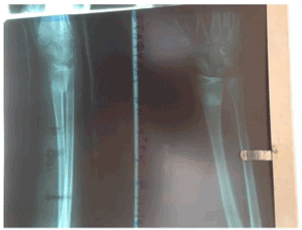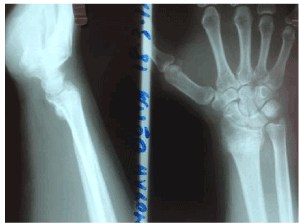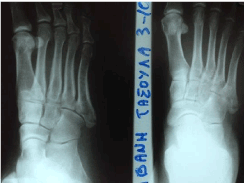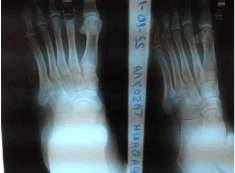Abstract
We present four cases of patients with bone fractures, which were treated with the aid of the Homeopathic Remedy Symphytum officinale. The Remedy was given to the patients after the proper alignment of the bone fragments was secured. Although in the first case the fracture was severely comminuted, and in the third and fourth, the patient’s compliance to the immobilization was very poor, the result of the treatment was excellent, both clinical and radiological.
Key words
bone, fracture, healing, homeopathy, Symphytum officinale
Introduction
Homeopathy, the “energy medicine”, is a branch of medical science based on the principle that disease can be cured by strengthening the body’s defense mechanism with substances selected for their energy-giving properties [1]. Symphytum officinale is the homeopathic remedy prepared from the common hedgerow plant – comfrey. Comfrey’s ancient English name is “knitbone”, and it is said that country bone-setters used it to repair broken bones. The story is that the bone would be set and then comfrey leaves would be bound to the area around the fracture with bandages.
We present four cases of fractured bones in which, after the alignment of the fractured fragments was established and secured, we used Symphytum officinale in order to speed up the healing process. In all of the cases, initially, the potency used was 30CH, once daily for 10 days, and then 200CH, once a week for the next three weeks. From our knowledge this is only the second report in the English literature describing the use of Homeopathy in the fracture treatment [2].
Case 1
A 34 years old semiprofessional football player presented to the clinic with a two weeks old comminuted fracture of his right clavicle, sustained during a football game (Figure 1a). In the x-ray there was not obvious callus formation, the patient was in severe pain and he was already offered surgery for open reduction and internal fixation of the comminuted fracture (Figure 1b). Another factor against conservative treatment of this comminuted fracture was that the patient – although being an athlete – was a heavy smoker, smoking more than two packets of cigarette for the last 15 years [2]. Nevertheless, we managed to convince him to continue conservative treatment with immobilization and the use of Syphytum officinale in the above mentioned protocol.
Figure 1


Figure 1a. The Injury Figure 1b. Two weeks post injury

Figure 1c. Three weeks after treatment with Symphytum officinale.
After three weeks the radiological picture was impressive (Figure 1c): there was definite and solid callus bridging the bone fragments, but most important, the clinical picture of the patient was excellent: he could abduct his shoulder joint painless for up to 120° and also admitted that he had already started using his arm since the week before for light manual work. We hardly convinced him to be very careful over the next few weeks. He returned to light training four weeks after the initiation of the Homeopathic treatment, and returned to foul practice just 8 weeks after his injury.
Case 2
A 15 years old football player presented to the Clinic with a minimally displaced fracture of the distal metaphysis of his right radius, sustained after a fall while training (Figure 2a). The alignment of the fragments was acceptable, so we continued treatment with immobilization in a full plaster along with the homeopathic treatment with Symphytum officinale, in the above mentioned protocol. Just three weeks after the injury, the x-rays showed solid callus formation in the fracture site (Figure 2b). The clinical and functional picture of the patient was excellent. He went back to light training in a week, and back to full practice just six weeks after the injury.
Figure 2


Figure 2a. The injury Figure 2b. Three weeks post injury.
Case 3
A 43 years old farmer presented to the clinic with a minimally displaced intraarticular fracture of the distal part of the radius after a fall (Figure 3a). He was offered conservative treatment with a below
Figure 3


Figure 3a. The injury Figure 3b. Three weeks post injury.
– elbow full plaster, but denied, stating that he should definitely had to use his hand in his daily activities. We finally agreed with him to treat him with a removable – futuro-type splint along with Symphytum officinale in the above mentioned protocol. Three weeks after the injury the patient presented to the clinic with the x-ray showing impressive and solid callus in the fracture site (Figure 3b). The patient stated that he has been using his hand almost daily, and that at the present time he only had some minimally pain and almost full function of his hand.
Case 4
A 68 years old lady presented to the clinic with a comminuted fracture of the fifth metatarsal bone after an inversion injury (Figure 4a). The patient was treated with a below – leg non – weight bearing plaster and the use of Symphytum officinale in the above mentioned protocol. Just nineteen days after the injury the patient presented to the clinic, full weight bearing in the plaster, with the x-ray showing excellent union of the fracture site (Figure 4b). Out of the plaster, the clinical and functional condition of the patient was excellent, and she left full weight bearing with only some minimal – protective limping.
Figure 4


Figure 4a. The injury Figure 4b. Three weeks after the injury.
Discussion
H. Zeeden in 1992 presented 5 cases demonstrating the enormous therapeutic effect of Symphytum Officinale in the musculoskeletal system [3]. Those cases included a delayed union of a fracture of the os naviculare, a post-traumatic pseudarthrosis of the sternum and a fatigue fracture.
Sakakura et al., in 2008, showed that administration of Symphytum 6CH in rats, definitely promoted an increase in radiographic bone density around titanium micro-implants placed in their tibia [4]. In the same experiment was shown that bone formation around the micro-implants was enhanced, mainly at 14 days, and definitely at 56 days, in comparison to the study group [5]. The conclusion of the study was that Symphytum officinale enhances, principally at the early stages of osseointegration, bone formation around titanium implants in rats tibiae, based on radiographic and mechanical analysis.
Oberbaum et al. in 1994, designed a study to test the working hypothesis according to which the administration of both Arnica and Symphytum to guinea pigs, following experimentally induced bone fractures, would both accelerate and improve fracture healing [6]. The results of this study showed that there was definitely statistical significant increase in the mineralization of new bone in the entire fracture site in the homeopathic treated group in comparison to the placebo group.
Homeopathy is a therapeutic system founded by the German doctor Samuel Christian F. Hahnemann (1755 – 1843). The word “homeopathy” is made up from the Greek words “omoios” meaning “similar” and “pathos” meaning “disease” [1]. The system is based mainly on the principle that the cure of a particular disease is achieved through the use of pharmaceutical substances that, when administered to a healthy person, produce the similar symptoms as those in the disease in question. The basic rule in homeopathy is that every living organism has its own defense system, either in the animal or in the plant kingdom and the doctor must, if possible, find the key which corresponds to the way each organism reacts to diseases [7].
Symphytum officinale, the comfrey root, has been used as a traditional medicinal plant for the treatment of painful muscle and joint complaints for centuries [8]. Boericke in his Materia Medica indicates Symphytum in non-union of fractures in capital letters [9], whereas Allen states that it is an excellent remedy for fracture and mechanical injuries, facilitates union of fractured bones and favors production of callus [10]. According to G. Vithoulkas’ Materia Medica notes, Symphytum officinale promotes the repair of broken bones, especially when they heal slowly. It helps the slow repair of broken bones (stated in capital letters), lessens peculiar bone pain and favors production of callus.
From our experience, Symphytum officinale in homeopathic potencies is a powerful tool for the medical practitioner treating bone fractures. It should be administered to the patient only after acceptable reduction of the fractured fragments has been secured (in order to avoid the possibility of mal-union). Even in very difficult cases or in patients with poor compliance, Symphytum can accelerate solid healing of the fractured bones.
Author’s contribution
Dionysis Tsintzas and Professor Vithoulkas participated in the whole process of conception of study.
All authors approved the final draft of the manuscript.
Conflict of interest
The authors declare no conflict of interest.
References
- Vithoulkas G (2012) The Science of Homeopathy. 6th ed. International Academy of Classical Homeopath., 2012.
- Sloan A, Hussain I, Maqsood M, Eremin O, El-Sheemy M (2010) The effects of smoking on fracture healing. Surgeon 8: 111-116. [Crossref]
- Zeeden H (1992) Symphytum. British Homeopathic Journal 81: 110.
- Sakakura K, Neto R, Belluci M, Wenzel A, Scaf G, et al. (2008) Influence of homeopathic treatment with comfrey on bone density around titanium implants. A digital subtraction radiography study in rats. Clin Oral Implants Res 19. [Crossref]
- Spin-Neto R, Belluci MM, Sakakura CE, Scaf G, Pepato MT, et al. (2010) Homeopathic Symphytum officinale increases removal torque and radiographic bone density around titanium implants in rats. Homeopathy 99: 249-254. [Crossref]
- Oberbaum M, Yakovlev E, Kaufman D, Shoshan S (2004) Effect of Arnica montana and Symphytum officinalis on bone healing in guinea pigs. British Homeopathic Journal 83: 90.
- Vithoulkas G, Carlino S (2010) The “continuum” of a unified theory of diseases. Med Sci Monit 16: SR7-15. [Crossref]
- Staiger C (2013) Comfrey root: from tradition to modern clinical trials. Wien Med Wochenschr 163: 58-64. [Crossref]
- Boericke W (2008) Boericke’s New Manual of Homeopathic Materia Medica with Repertory B. Jain Publishers (P) Ltd.
- Allen TF (2011) The Encyclopedia of Pure Materia Medica. Narayana – Verlag.





